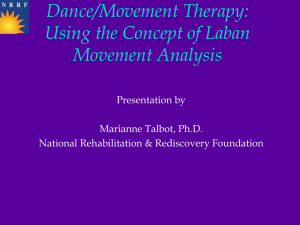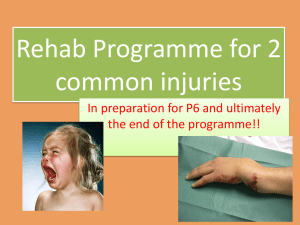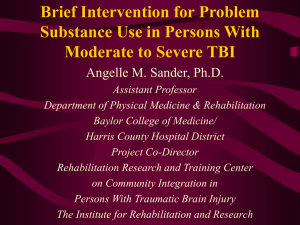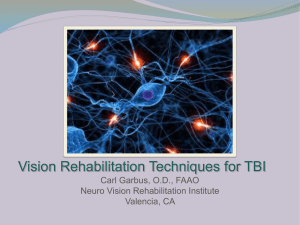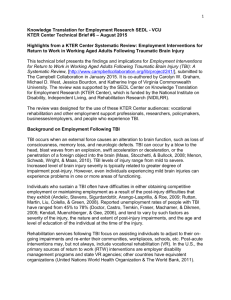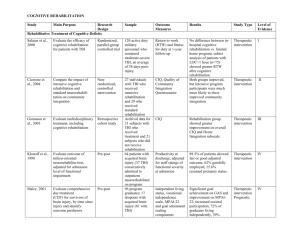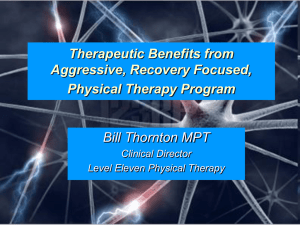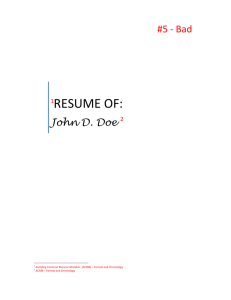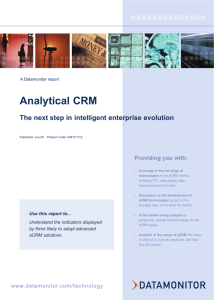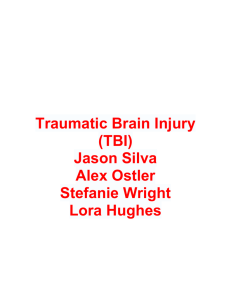Evidence Based Cognitive Rehabilitation
advertisement
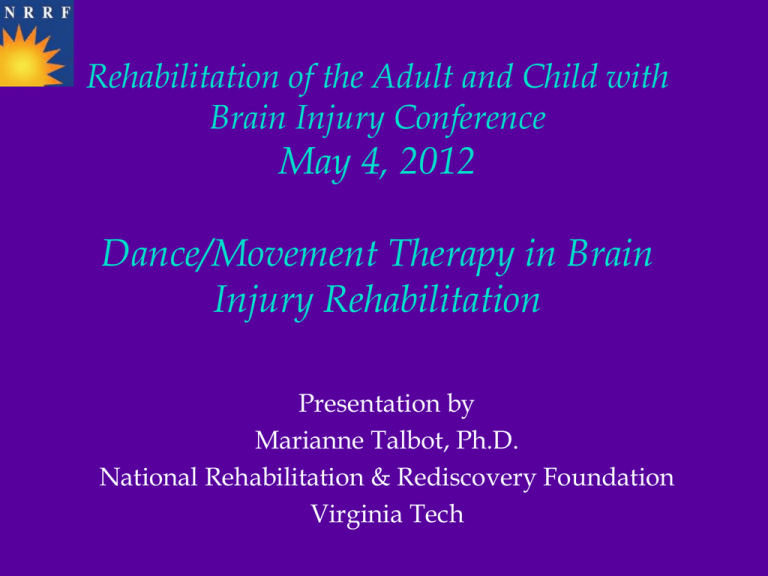
Rehabilitation of the Adult and Child with Brain Injury Conference May 4, 2012 Dance/Movement Therapy in Brain Injury Rehabilitation Presentation by Marianne Talbot, Ph.D. National Rehabilitation & Rediscovery Foundation Virginia Tech Brain Injury ISIG, ACRM Objectives Demonstrate an understanding of dance/movement therapy and its implications in brain injury rehabilitation Understand the differences between conventional physical therapy and dance/movement therapy in brain injury rehabilitation Brain Injury ISIG, ACRM Importance Historically, treatment interventions for individuals with brain injuries have focused on conventional modalities including physical, occupational, and speech therapies, and cognitive rehabilitation Much of the current research indicates there is a significant need to determine which treatment methods are most effective in ameliorating the physical, cognitive, and psychosocial consequences of individuals with brain injuries resulting in optimal long-term outcome Meaningful measurement systems need to address individual satisfaction, long-term outcome, and quality of and satisfaction with life Purpose of the Study To better understand the dynamics of a therapeutic dance/movement intervention for individuals with brain injuries by comparing it to a conventional physical therapy intervention using Laban Movement Analysis (LMA). Dance and Movement Therapy The psychotherapeutic use of movement to promote emotional, cognitive, physical, and social integration of individuals D/M Therapy is practiced in mental health, rehabilitation, medical, educational, and forensic settings, and in nursing homes, day care centers, disease prevention and health promotion programs Brain Injury ISIG, ACRM Laban Movement Analysis Systematic approach to observing, describing, and analyzing quantitative and qualitative changes in human movement through Body, Effort, Space, and Shape (BESS) Provides a comprehensive language and analytic framework for the description and recording of human movement Body, Effort, Space and Shape Body describes the action of the torso and limbs by observing body attitude, whole body and body part movement, and developmental patterns Body Attitude – The BESS baseline. General and specific impression of maintained or constantly recurring postural characteristics Whole Body – Homologous, homolateral, contralateral, trunk/limb relationship, use of trunk, posture gesture merger Use of Body Parts – carriage, gesture vs. support, body part awareness, limb relationship, center of gravity Developmental Patterns – naval radiation, spinal, breath support and phrasing, core support, weight shift, spatial intent Brain Injury ISIG, ACRM Effort Effort describes how the body concentrates its exertion as the body changes in its quality of movement through Time, Weight, Space, and Flow Effort Space Weight Time Flow Indulging Indirect Light Sustained Free Condensing Direct Strong Quick Bound Brain Injury ISIG, ACRM Space and Shape Space describes the location, amount and symmetry of the external space one uses during movement which includes space harmony, one’s outer architecture, and one’s kinesphere Shape describes the movement of the body’s internal components in supporting or influencing external activity such as with one’s inner architecture, shape flow, directional movements, and shaping qualities Movement Themes Inner/Outer Exertion/Recuperation Mobile/Stable Function/Expression Bodily-kinesthetic Learning Historically, treatment interventions for individuals with TBI have concentrated on the physical, cognitive, and behavioral effects resulting from injury through the provision of physical, occupational, and speech therapies. Much less focus has been placed on integrating all these domains and including the psychosocial needs of individuals with brain injuries to create an integrated mind and body approach to rehabilitation. Findings What are the similarities and differences between the dynamics of physical therapy and therapeutic dance/movement as interventions for individuals with brain injuries? Physical therapy intervention lends itself to the observation, analysis, and treatment of the biomechanical aspects of movement from a functional single joint action and muscle activity perspective Physical therapy intervention helps strengthen and stretch specific muscle groups Dance/movement intervention observes, analyses, and treats individuals from a whole body-mind (integrating physical, cognitive, and psychosocial components), Functional and Expressive perspective Findings Continued What are the dynamics of the therapeutic dance/movement intervention? LMA Components Core and Breath Support and Grounding Aspects of Shape (Shape Flow, Directional Movement, Shaping) Effort-Life Movement Themes Whole/Part Inner/Outer Function/Expression Exertion/Recuperation Mobility/Stability Findings Continued Dynamics are multi-faceted Individual movement patterns remained fairly constant however, at times, we appeared to embody aspects of each other’s Effort-Life and sense of rhythm as we shared in each other’s Kinesphere Shaping was used to connect with each other especially when using touch to support movement Relationships and relating to each other contributed to the overall dynamic interaction Promoted creative and expressive experiences to feel and sense one’s self and others within a safe and supportive group environment Facilitated growth and change Significance and Meaning Illumination of a potential rehabilitative intervention using an integrative-holistic approach to treating individuals with brain injuries Introduction to and potential use of measurement system - Laban Movement Analysis Witnessing adult learning and human development post brain injury using a non-conventional therapeutic intervention Questions To what extent would an individual’s perceived quality of life improve if each brain injury treatment intervention employed a holistic-integrative perspective within their specialty areas? Would it be valuable for each brain injury intervention to measure an individual’s quality of life in addition to measuring discrete components such as range of motion, procedural memory, or performance of activities of daily living? To what extent is a treatment modality considered efficacious if the intervention is not contributing to the individual’s sense of improved quality of life? Could LMA be a meaningful system for measuring an individual’s long-term outcome and quality of life? Foundations in Adult TBI Effects of TBI on underlying brain structures and function, and adjustments needed for (re)learning. Effects of TBI on family, work, and society. Role of societal agents in rehabilitation and rediscovery processes. Attention to injuries from war, sports, accidents, and other causes. Understanding adulthood pre and post TBI Understanding the experience from multiple perspectives Learning adjustments in adulthood Issues in Adult TBI Advances in TBI practice, policy, and research Translating theory into practice Relevance of rehabilitative challenges and practices to theory Raising awareness, understanding, and action in society at-large International efforts and societal implications Internship/Independent Study Independent studies must be related to TBI and must follow completion of both the Foundations and Issues courses In lieu of an independent study, an internship may be available on a selected basis where qualified on-site supervisors are available Profiles of Therapeutic Interventions Mobility/ Stability Effort-Life Whole/Part Inner/ Outer Core/B. Support Grounding Exertion/ Recuperation Aspects of Shape Stability for Mobility Body Level Connect. Single Joint Actions Exertion/ Recuperation What are the dynamics of the therapeutic dance/movement intervention? LMA Components Core and Breath Support and Grounding Aspects of Shape (Shape Flow, Directional Movement, Shaping) Effort-Life Movement Themes Whole/Part Inner/Outer Function/Expression Exertion/Recuperation
